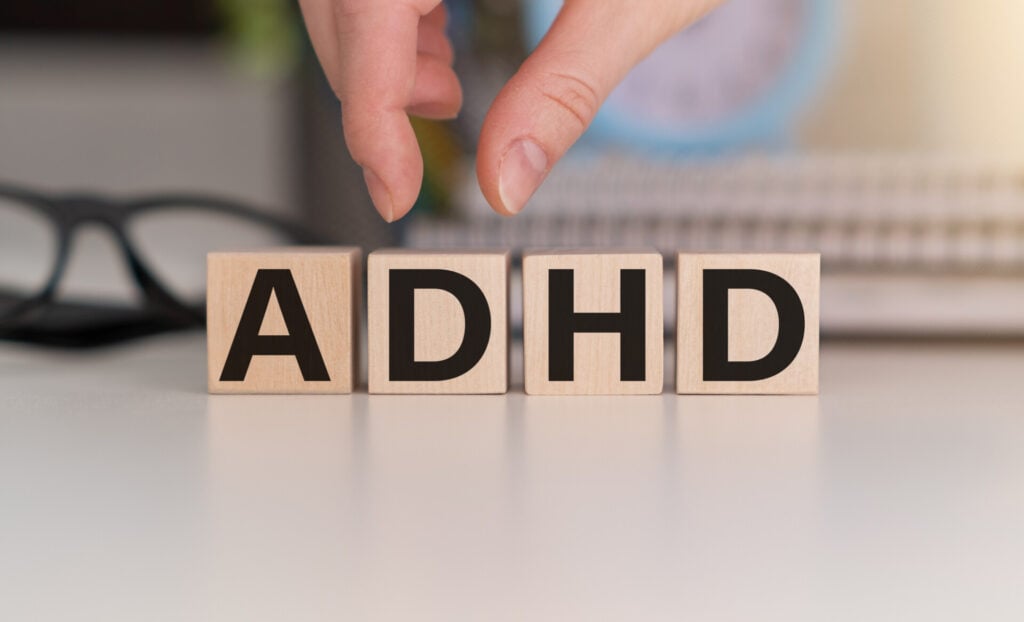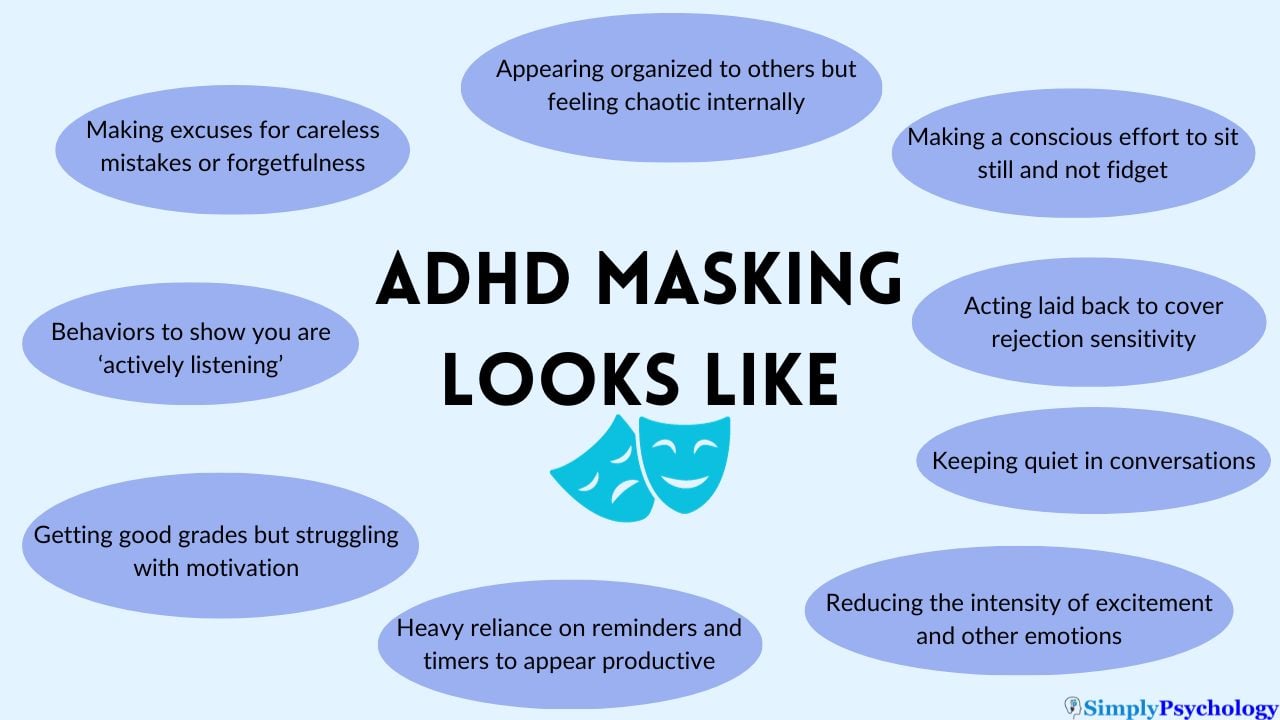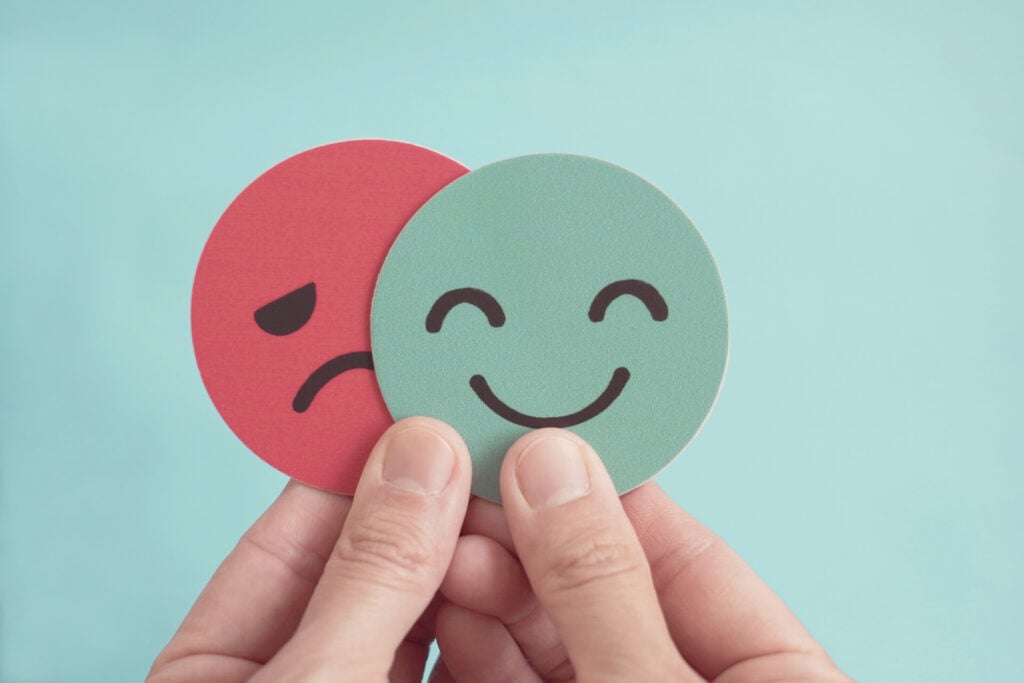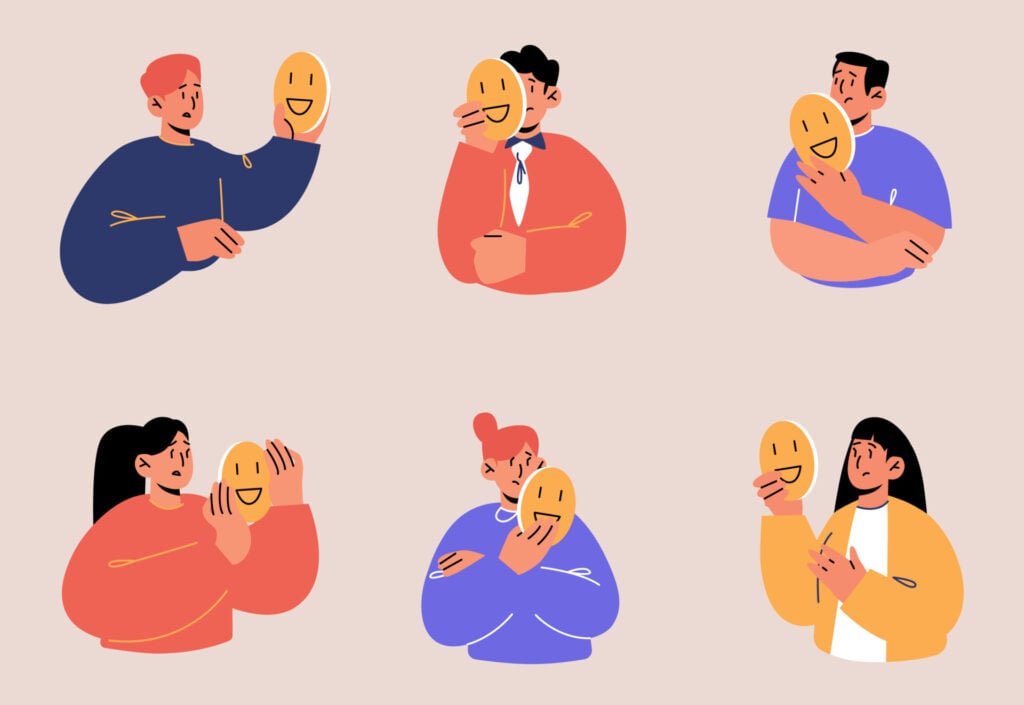On This Page:
Masking in attention deficit hyperactivity disorder (ADHD) refers to the conscious or subconscious efforts of individuals to hide or suppress their symptoms in order to conform to social expectations or avoid negative judgments and stigmatization.
This form of behavioral modification can also be referred to as “impression management” and is usually done in an attempt to overcompensate or camouflage one’s ADHD tendencies (Barkley, 2020).

ADHD masking Examples
There are many ways in which ADHD symptoms can be masked. Below are some examples:
- Hiding your true feelings and presenting behaviors that would be more neurotypical instead
- Trying to suppress certain soothing behaviors, such as stimming (self-stimulating behavior)
- Masking the fact that you worry about criticism and negative feedback by portraying a more nonchalant persona
- Developing the need to obsessively check over things, e.g., your personal possessions
- Being overly apologetic to hide tendencies of forgetfulness or lack of focus
- Remaining silent or withdrawn in social situations out of worry of judgments over ADHD symptomatology
- Striving for perfectionism at most things you do
- Taking on too much in order to showcase your capability and override any emotions of not being good enough
- Expending a lot of energy actively listening to ensure you do not miss any social cues or what is being said
- Masking any emotions such as fatigue, anxiety, or self-doubt
“I used to literally bite my lip to stop interrupting and until it bled.”
Dr Alex Conner

Individuals with ADHD may learn to mask their symptoms, especially if they have not been diagnosed and treated.
This can make it even harder for clinicians to identify ADHD, as the individual may appear to be anxious or shy rather than displaying typical ADHD symptoms.
This can be further exacerbated in girls and women as they often go underdiagnosed or misdiagnosed (Lai, Lin & Ameis, 2022).
Racial and ethnic minority groups are also more likely to mask due to the additional factor of discrimination they may face, reducing the likelihood of early detection and diagnosis.
“I’ve lost a little bit of my own ethnic culture and my own foundations… I’m South Asian and Pakistani. I’ve lost a little bit of that … to try and become something I’m not.”
Sonya Barlow, Author (2023)
What ADHD Symptoms are Masked?
There are countless ways in which ADHD can be expressed and explained, so some people may mask some symptoms but not others. That being said, there are some more common behaviors frequently associated with impression management.
One such example is impulsive behavior. This could range from frequently holding back the urge to interrupt or react quickly without much thought.
Another behavior frequently masked is inattention. This could range from forcing yourself to concentrate when someone is talking to mimicking body language to show you are actively listening to what is being said.
Also, hyperactivity and self-regulatory behaviors such as stimming are often attempted to be camouflaged in social situations.
This could look like forcing yourself to sit still and not fidget or restricting body language, e.g., crossing arms or legs to avoid squirming.
Do neurotypicals mask?
Neurotypical people can indeed mask as well. Various situations could arise, which can then prompt them to adopt their own versions of a “persona” to help them navigate situations and feel that they need to camouflage how they would really act or react, respectively.
The desire to be accepted and fit in with peers is one such primary case shared amongst most people, regardless if they are neurotypical or neurodivergent. Masking can help support this, but the reasoning behind it differs.
Masking ADHD can help people feel like they are behaving in more neurotypical ways (Jorgenson, Lewis, Rose & Kanne, 2020), while for neurotypicals, it can help mask any behaviors perceived as less socially desirable, e.g., being more introverted.
Additionally, this camouflaging can also happen in professional and work environments, for example, during a presentation to hide nerves or during a job interview where they want to be portrayed a certain way.
Lastly, masking may arise in neurotypical individuals who may be struggling with their mental health, e.g., depression or anxiety.
For example, they may try to portray a more confident version of themselves to hide their social anxiety or put on a smile to hide their low mood.
Why do People with ADHD Mask?

There are several reasons why people with ADHD mask, and it can differ from person to person. However, there are some common underlying motivational factors that often drive the desire to mask (Sarenius, 2022).
Desire to belong
One such reason is the desire to belong and societal pressures. The majority of people crave social connections and want to fit in with their peers and society as a whole.
Masking ADHD can help people feel like they are behaving in more neurotypical ways, which can, in turn, reduce perceived notions of being an outsider or feelings of unwantedness.
“I always felt like I had to perform in order for people to understand my intentions, which I think is a feeling that a lot of us can relate to with masking. Like, let me go above and beyond to show that I can be responsible and kind and pleasing and obedient… because you need approval.”
René Brooks, Educator
Fear of being socially rejected
Following on from this, another reason for ADHD masking linking to the previous point is fear of stigmatization and bullying.
A few ADHD behaviors, such as impulsivity, may not be very accepted in social situations, so masking and suppressing such urges can act as a protective mechanism against potential judgment or criticism.
Being neurotypical is ‘favored’
Neurotypical behavior is usually favored in most societies and cultures, further deriving the need to camouflage neurodivergent tendencies and reactions.
For example, in the workplace, it may be seen as better to be focused and attentive rather than unfocused and inattentive, which are some of the primary ADHD symptoms.
Such behaviors may be restricted or scolded starting from a young age. Children displaying neurodivergent or ADHD behavior, such as lack of concentration or impulsiveness, e.g., shouting out answers in class, may be chastised by teachers or ostracized by fellow students and peers.
The notion that it is unfavorable to act in such ways can thus push people to begin masking who they are instead of being their authentic self.
Why Can Masking be a Problem?
Masking, while certainly offering several benefits to individuals with ADHD, can turn problematic when activated too frequently and for long spouts of time.
There are still several societal situations, cultural, ethnic, and religious structures, and daily instances where people on the neurodiversity spectrum may feel unsafe or uncomfortable being themselves.
Hiding their ADHD symptoms can thus become a default mode (even activated unconsciously if relied on and engaged in frequently), leading to several potential problems.
Such issues can manifest either in isolation or usually in various combinations due to the intricate interconnectedness between them.
Consequently, and more often than not, one issue can lead to another, generating an array of problems.
Let us now discuss some of the most common issues that may arise from masking.
Burnouts
Constant self-monitoring of emotions and behaviors can naturally become absolutely exhausting due to the heavy censorship and cognitive energy masking requires.
The worry, anxiety, and other related symptoms that can arise when camouflaging add to this mental load, further exacerbating the situation.
Consequently, this can lead to feelings of fatigue and burnout, with the body not being able to cope with the stress it is being put under.
“I tried to mask and I try to mask maybe so hard that I didn’t realize I was masking and then eventually I got exhausted from masking because it hurts your brain and it makes you feel tired.”
Sonya Barlow, Author (2023)
Decreased self-esteem
Masking can lead to a sense of disconnect between who you are and your wish to be authentic vs. the version of yourself that you portray when engaging in masking behavior.
This frequent hiding of your genuine self can begin to take a toll and massively plummet positive self-perceptions.
With time, this can lead to a reduction of self-esteem, confidence, and unhelpful thought patterns, significantly increasing the chances of mental health struggles such as depression as well (Sowislo & Orth, 2013).
“I’ve got really low self-esteem, and I think I’m [ __ ] at everything, and I don’t want people to know how [ __ ] I am, so I think I do my best to hide it.”
Sam Brown
Low sense of self
Linking to a decreased self-esteem due to the dissociation of the authentic you and masked you, a low sense of self can begin to develop.
Feelings of inadequacy and hyper-focusing on just the negative can begin to arise due to the different masks people have to remember to wear depending on the person/occasion, potentially making them further overwhelmed and unsure of which version of themselves to be.
Consequently, this can generate feelings of loss and confusion over what your true identity is and further agitate negative self-perceptions and judgments.
Can be distracting
Distraction is something many people with ADHD battle with, and it can become exacerbated with masking as a byproduct of the cognitive demand it takes on one’s mental load.
Instead of being able to be fully present, available, and focused in social situations, there are thoughts around censorship and behavioral management constantly circulating.
It can thus increase the prominence of loss of focus and overall contribute to reduced productivity.
Increased anxiety
Feeling that your true identity may not be accepted, respected, or cared for in specific social settings, and as a result, you need to mask and hide part of yourself, can ultimately lead to increased anxiety.
The constant worry of not wishing others to recognize or see you struggling can also contribute to this. Lastly, being stressed when going out or not enjoying your time are common adjacent symptoms.
Imposter syndrome
Imposter syndrome describes when someone feels like their achievements and successes have not been rightfully earned despite any clear evidence proving otherwise.
This sense of self-fraud may arise from masking again due to the disconnect between one’s real self and the persona they adopt in social settings. As a result, this can prevent people from being present and enjoying their time interacting with others.
Late diagnosis
Effectively masking your symptoms can make it harder for others to notice that you have any difficulties and offer the correct avenues for care and support.
This can make it less likely that you will be referred for an early diagnosis, further exacerbating pockets where you are left dealing with symptoms alone.
Late diagnosis is thus more likely (especially for women), which can make it harder for someone to re-learn maladaptive behaviors they have been engaging in and relying on for years.
Depressed feelings
Due to the previously outlined reasons, all this emotional turmoil, anxiety, and identity disconnect can really take a harsh toll on someone’s psyche.
Feelings of extreme sadness, low moods, and bouts of depression can then arise, potentially further isolating someone.
This can also heighten the need to camouflage, creating a vicious cycle of masking symptoms whose etiology stems from said masking itself (Meinzer et al., 2013; Quinn & Madhoo, 2014).
Substance abuse
Lastly, and linking with the previous points, all of these overwhelming emotions can become unmanageable and lead someone down the path of substance abuse, e.g., alcohol or drugs, in an attempt to cope with the situation.
This can lead to a whole other array of additional symptoms and situations needing further masking, creating another potential vicious cycle of dependency.
Such substance abuse can develop into a further form of masking, hiding ADHD symptomatology (Katzman, Bilkey, Chokka, Fallu & Klassen, (2017)
Can Masking be Beneficial?

Masking can certainly be beneficial for individuals with ADHD and can act as a behavioral mechanism aimed at guiding people in navigating day-to-day life and social expectations.
The main benefits of masking rely on a sense of belonging and “fitting in” with the rest of one’s peers, social groups, and overall society as a whole.
This can range from outings with friends to even more career-oriented situations and professional settings, such as helping you get a job.
By masking any ADHD reactions and symptomatology, people may feel safer and develop a higher sense of confidence, in turn, feeling more accepted by the world around them.
Masking may also be beneficial in reducing forms of social stigmatization and exclusion. Fears of being discriminated against or even bullied can often plague people with ADHD.
Through masking, any potential negative attention can be reduced and help people feel safer and create a sense of “blending in.”
It is important to note that despite having certain benefits, excessively engaging and relying on masking can start having the opposite of any desired effects.
Balance is key to avoiding severe side effects such as burnout and deconstruction of a sense of self.
Masking vs Mirroring
Masking and mirroring are two forms of behavior often associated with ADHD and overall neurodivergent behavioral adjustments in general.
While both are forms of modification in an attempt to better align with current perceived societal norms and avoid negative judgment, their underlying mechanisms and reasonings behind engaging in them differ.
For masking, its primary function is assimilating with one’s environment and societal expectations by hiding or suppressing one’s ADHD symptoms.
This could look like hiding behaviors such as impulsivity, lack of focus, and heightened reactivity by suppressing, avoiding, or deflecting emotions and other related tendencies.
For mirroring, its primary function is assimilating with one’s environment and societal expectations by “copying” what others are doing.
This could look like mirroring behaviors such as facial expressions (e.g., smiling), eye contact, and overall body language.
How to Deal with Masking

Masking, despite its benefits in certain situations, can undoubtedly lead to various problems and issues.
ADHD, in general, while having similarities across the board, can still be a unique and individualistic experience due to the intricacies of human behavior and life.
This then gets translated further into these coping strategies, such as masking, making them an important aspect of one’s life requiring attention.
It is thus important to support people in their neurodiversity journey and ensure they have access to the best support and help to ensure they can express themselves as healthily and authentically as possible.
Symptom management for masking behaviors is, therefore, key for ADHD regardless of age and gender.
A lot of these support avenues can also extend as pointers for people who know someone with ADHD in their lives.
Loved ones, friends, and allies in general, can have a key role in supporting masking behaviors. Educating one’s self further is an excellent first step in creating a more welcoming and inclusive environment.
There are several ways someone can deal with masking. Let us discuss and outline some of the most common methods.
Get treatment and a diagnosis
Ensuring you have access to the proper treatment and diagnosis is key when dealing with masking and overall ADHD symptomatology.
This can help ensure the information and care you are receiving will be the most appropriate and tailored to your individual needs and ADHD-expressed behaviors.
It is often recommended to reach out and engage with your nearest and most accessible mental health professional to get the appropriate support and guidance.
Identify the masking behaviors
Recognizing masking behaviors linked with ADHD is the first step in dealing with and coping with impression management symptoms.
Is there a difference in how you behave at home in your own company compared to social situations? Do you feel the need to mask who you are with certain people and not others?
These are some questions you may begin thinking over. By identifying masking behaviors for what they are and reflecting on under which circumstances you seem to be engaging in them, you will further understand your neurodiverse traits better.
Separate healthy and unhealthy behaviors
Not all masking behavior is unhealthy, but not all masking behavior is healthy, either.
Each person is unique in their situation, life, needs, environmental factors, etc., and how ADHD connects with all these variables.
Self-reflect on your actions, identify which masking behaviors are not helping you live your authentic life, e.g., hiding if you are stressed or masking your need to fidget, and begin separating between what is helping you progress or potentially worsening the situation.
“I am continuing to learn what does and doesn’t work for me regarding medication and behavior modification. It’s a journey and sometimes, quite frankly, it’s a pain in the butt. But it’s so worth it.”
‘Ellen’ diagnosed with ADHD in her 50s.
Work on emotional regulation
Emotional dysregulation and inability to control feelings can be the underlying cause leading to masking for many.
Masking is not the only way or solution that can be utilized to help support someone in social situations. By working on alternative emotional regulation strategies and healthy coping mechanisms, you can reduce your need for masking and begin a positive journey moving forward using additional methodologies.
Some examples of alternatives are mindfulness, journaling, and engaging in therapy.
Celebrate your strengths
Never forget to cheer yourself on and celebrate your strengths. It can become easy to mainly focus on the negative, especially when areas such as self-esteem or imposter syndrome start to manifest.
However, it is important to pause and reflect on where you were and where you are now. Give yourself some much-needed self-love and acceptance, and remember to celebrate your achievements.
“I’m not trying to wear a mask and you know what there’s seven billion people in the world so if they don’t like you somebody will eventually.”
Sonya Barlow, Author (2023)
Consider dropping the mask
Everyone is unique in their choices and desires, so masking may not benefit many.
If you feel like you are in a safe environment to do so, it might be worth considering dropping the mask.
“The only people I unmasked around were either real friends or real friends who I know also have ADHD. I have plenty of acquaintance-level people I won’t unmask (or at least do my best not to) around & unsafe people including members of my own family.”
‘Rita’
Allowing yourself to both feel and express your emotions and behaviors freely and authentically can help reduce feelings of anxiety, imposter syndrome, and burnout.
You can start around people who you trust and who accept you as you are. For example, you can gradually drop behaviors (rather than all at once) and reassure others that any noticeable changes in your behavior are due to you dropping the mask rather than anything they may have done specifically.
This is, of course, with the caveat of remaining respectful and not saying hurtful things or engaging in harmful behavior.
“One example for me was hanging out with friends without having something to do while we talk. My friends now know that I listen better if I’m knitting or stitching or even playing a simple game on my phone. So if they see me doing that, they don’t immediately assume I’m “checking out” of the conversation. When I was masking, I felt like I had to keep “normal” amounts of eye contact, and it was miserable and exhausting. It made me not want to be around people at all.”
‘Harriet’
Frequently Asked Questions
Is masking a form of self-sabotage?
Masking is not inherently a form of self-sabotage as its primary function is assimilating with one’s environment and the current societal expectations to avoid negative judgments.
However, it can become maladaptive and turn into a state of self-sabotaging if utilized excessively and for extended periods of time.
More specifically, by suppressing one’s true sense of self, emotions, and desired ways they would like to naturally react to situations, incongruency between their identity and their masked “persona” can arise.
Consequently, confusion, fatigue, low self-esteem, and even social aversion can result.
Is masking in ADHD the same as Autism masking?
While there are some similarities between ADHD and Autistic masking, they are not inherently the same.
Both forms of masking focus on a form of behavioral/emotional suppression and alternation to fit in with neurotypical societal expectations (Taurines et al., 2012). However, where they differ is what they are attempting to mask.
For ADHD, this would usually be behaviors such as impulsivity, trouble focusing, and reactivity.
For Autism, masking may reflect behaviors such as holding back on talking about special interests, mimicking neurotypical social queues (e.g., maintaining eye contact), and suppressing physical discomfort (e.g., reactions to noise overstimulation).
How do you know when masking is no longer helpful?
Masking may no longer be helpful in several instances, but here are a few key examples to look out for.
Firstly, if you are experiencing elevated levels of anxiety that are starting to impact your daily life. Secondly, physical and mental exhaustion from engaging or sustaining masking behaviors for long.
Thirdly, a significant decrease in self-esteem and an overall lack of positive outlooks about who you are as a person.
Lastly, a sense of imposter syndrome and the belief that you are incapable of deeply connecting with others.
While these are some common signs that masking may no longer be helpful, it is not an exhaustive list.
Each person is unique in their behavior, so what might be a warning sign for one may not be for another.
Can ADHD be masked as anxiety?
In certain cases, ADHD can be masked as anxiety due to some underlying commonality between the two conditions. More specifically, both can share mental and physical symptomatology (Schatz & Rostain, 2006).
Mentally, both can lead to difficulty concentrating, trouble remembering things, and disorganization. Physically, both can lead to muscle tension, fidgeting, or feeling restless and headaches.
Additionally, having ADHD increases your chances of experiencing anxiety which can further contribute to potential confusion about the underlying symptom causes.
If in doubt, consulting a mental health care professional specializing in ADHD and neurodiversity is advisable.
Lastly, ADHD symptoms may be wrongfully diagnosed as an anxiety disorder, completely bypassing ADHD entirely. While it’s possible to have both, if anxiety is diagnosed first, all symptoms of ADHD may be written off as signs of anxiety, potentially further delaying correct treatment.
References
Barkley, R. A. (2020). Taking charge of ADHD: The complete, authoritative guide for parents. Guilford Publications.
Barlow, S. (Presenter). (2023, July 25). BBC Presenter: I’m Finally Being My Authentic Self – Sonya Barlow [Video]. https://www.youtube.com/watch?v=6AdH54tniiY
Chung, W., Jiang, S. F., Paksarian, D., Nikolaidis, A., Castellanos, F. X., Merikangas, K. R., & Milham, M. P. (2019). Trends in the prevalence and incidence of attention-deficit/hyperactivity disorder among adults and children of different racial and ethnic groups. JAMA network open, 2(11), e1914344-e1914344.
Jorgenson, C., Lewis, T., Rose, C., & Kanne, S. (2020). Social camouflaging in autistic and neurotypical adolescents: A pilot study of differences by sex and diagnosis. Journal of Autism and Developmental Disorders, 50, 4344-4355.
Katzman, M. A., Bilkey, T. S., Chokka, P. R., Fallu, A., & Klassen, L. J. (2017). Adult ADHD and comorbid disorders: clinical implications of a dimensional approach. BMC psychiatry, 17, 1-15.
Lai, M. C., Lin, H. Y., & Ameis, S. H. (2022). Towards equitable diagnoses for autism and attention-deficit/hyperactivity disorder across sexes and genders. Current Opinion in Psychiatry, 35(2), 90-100.
Meinzer, M. C., Lewinsohn, P. M., Pettit, J. W., Seeley, J. R., Gau, J. M., Chronis‐Tuscano, A., & Waxmonsky, J. G. (2013). Attention–deficit/hyperactivity disorder in adolescence predicts onset of major depressive disorder through early adulthood. Depression and Anxiety, 30(6), 546-553.
Quinn, P. O., & Madhoo, M. (2014). A review of attention-deficit/hyperactivity disorder in women and girls: uncovering this hidden diagnosis. The primary care companion for CNS disorders, 16(3), 27250.
Sarenius, A. (2022). Masking: The Constant State of Seeking and Becoming.
Schatz, D. B., & Rostain, A. L. (2006). ADHD with comorbid anxiety: a review of the current literature. Journal of Attention disorders, 10(2), 141-149.
Sowislo, J. F., & Orth, U. (2013). Does low self-esteem predict depression and anxiety? A meta-analysis of longitudinal studies. Psychological bulletin, 139(1), 213.
Taurines, R., Schwenck, C., Westerwald, E., Sachse, M., Siniatchkin, M., & Freitag, C. (2012). ADHD and autism: differential diagnosis or overlapping traits? A selective review. ADHD Attention Deficit and Hyperactivity Disorders, 4, 115-139.


